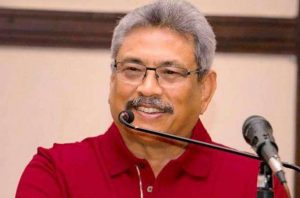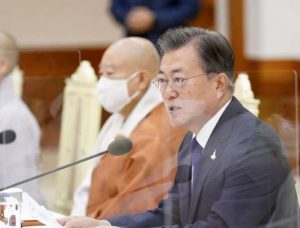
Have you ever been to a Buddhist temple and seen small children—even infants in diapers—do prostrations? It’s very cute. They put their dimpled little hands in the anjali mudra and then drop to the floor, lying flat, then scramble back up. Sometimes it’s habit that propels them down that short distance, and sometimes they are encouraged by the adults around them. Sometimes they try out the refuge vow in languages that they may or may not understand. Sometimes they forget what they are doing and just lie there, staring at the floorboards until someone reminds them to stand up.
They are most likely participating in the culture of their family or country, following the example set by the people around them. It’s less likely that they are genuinely offering their body, speech, and mind to the Buddha, Dharma, and Sangha. But they are definitely pleasing the adults around them, as evidenced by the coos of delight and words of affirmation. Attention is the currency of children, so everyone is happy.
Over time, working with young people in Buddhist environments in the West, I’ve thought a lot about this practice of encouraging children to take refuge. Of course, it’s natural in Buddhist-heritage countries to prostrate to the Buddha at any age, to chant:
In the excellent Buddha, Dharma, and Sangha,
I take refuge until enlightenment.
By the merit of giving and the rest,
May I attain buddhahood for the sake of all beings.
But as the Buddha himself taught, it’s always good to examine our actions so that they are in accord with our beliefs. So caregivers may still find value in considering a few things before they urge their little ones to bow down.

Even if they don’t understand the implications, taking refuge could help children to develop a karmic link with the Dharma. Clearly they already have a certain karmic connection if they are in a Buddhist family or find themselves in a temple. Sounding out the refuge vow and going through the motions may increase their merit and create the precise auspicious circumstances for them to deliberately submit themselves to the Triple Gem in the future.
When I posed the question to Elizabeth Mattis Namgyal last year in Colorado—should children take refuge?—she took her time to answer thoughtfully. “There is something that has to happen before real refuge can take place” she said. “A sort of ‘pre-refuge.’” She went on to describe this pre-refuge as a kind of disenchantment. “There’s a roughness about pre-refuge; you have to face what is disappointing about life. You have to get a little heartbroken.” She explained that genuine refuge requires us to see that we can no longer hold the world responsible for our suffering. The Dharma is a refuge because it trains us to let go of that expectation and the disappointment to which it leads.
Is there a risk to taking refuge before the heart has been broken in this way? If children follow the lead of adults, mimicking refuge, they will one day begin to develop awareness of what the words really mean. As they begin to make more choices for themselves, they might resent having been made to voice commitments without any agency. The words might seem empty—a cultural practice with no connection to their lived experience. Or worse, what if taking a vow of refuge and then not abiding by that vow depleted their merit in some way.
But my friend Khenpo Sonam offered some solace: “Not all refuge is the same. If you are forced to take refuge, it’s not a real commitment. And therefore there is no merit, good or bad. It is a matter of action without results. A burnt seed will not grow.”
He qualified this by pointing to the motivation aspect of refuge: “People usually take refuge out of faith, fear, and compassion. The result depends on those causes and conditions. But all three need renunciation. If there is no renunciation then it’s on the same par as taking refuge for personal gain, like good health or fame or power.”
If that’s the case, children are outliers. They often take refuge because it’s fun. It’s fun to get a secret name, it’s fun to move their bodies, to be part of something.
My young friend Maya, who is a second-generation Buddhist, recently shared her story with me.
I took refuge when I was quite young, maybe seven. I don’t think my parents suggested it overtly, it was more like all of the kids decided it would be a fun thing to do together. It’s sort of cool that we all had that inspiration. And getting a refuge name was quite exciting. Of course, how much did we take to heart what we were taking refuge in? I can’t be so sure. Many of my friends who took refuge that day aren’t practicing Buddhists, but it’s nice to imagine that their intentions and connections were positive. That even if the deeper, more profound meaning wasn’t fully formed then, that it has been there before and perhaps it will eventually be there again.
Maya began actively studying and practicing the Dharma 19 years later, when she took refuge again and started her preliminary practices.
What is the alternative? One option would be to preclude children from taking refuge until they can make a conscious choice, perhaps offering it as an option in their teens and making a ceremony out of it. Taking refuge with intention would feel significant, even momentous; a Buddha Mitzvah. It would mark the actual starting point of the child’s journey on the path.
Then again, it seems odd to prevent a child from doing something so auspicious.
In a conversation with a Buddhist friend who grew up Catholic, an idea emerged that Buddhists could adopt something akin to the Catholic baptism, a parent-enforced ceremony that is followed by a more intentional confirmation. Mirroring this, young Buddhist children could take refuge as a sort of precursor, a planting of the seed, and then when they reach their teens they can choose to let that blossom by confirming their trust.
When I was teaching at a Buddhist school for children, we introduced refuge experientially. The guiding question was: how does it feel to take refuge and how does it feel to be a refuge for others? Children learn by using their bodies, moving, singing, chanting, so we relied on these methods. They also love parties and celebrations. So it’s not surprising that they enjoyed the act of doing prostrations. But we made a decision not to encourage children to take refuge, partly because 90 per cent of the families attending the school did not identify as Buddhist.

This parameter of “no refuge vows” allowed us to explore ways for children to arrive at their own understanding, and to have a felt sense of the word. Our challenge was to convey the essence of refuge—reverence, protection, and inspiration—in ways that were appropriate to a child’s developmental stage.
So we started by doing things such as looking at how insects and animals build their homes, and noticing who they could go to in their school community if they needed help. We introduced the practice of taking inner refuge, building the skills to find that calm, centered part of themselves that they can access at all times. This inner refuge practice carried over and deepened through all the years.
By age six, students had a relationship to the word refuge and their metacognitive awareness was sufficiently developed to introduce a more cognitive refuge. They were ready to learn about how some people take refuge in the Buddha, his teachings, and the community who practice those teachings. Around age eight, children are developing questions about life and death. At this point, a more nuanced Dharma refuge could be introduced. To help them relate to this idea, Dzongsar Khyentse Rinpoche wrote us a special refuge prayer for the children:
I accept the truth.
I respect the one who taught the truth.
I belong to the community of truth seekers.
Older students explored refuge through an anthropological lens, noticing the differences and similarities between Theravada, Mahayana, and Vajrayana practices, the different recitations, ceremonies, styles of bowing or prostrating, and the vows that are taken. A key learning at this age was that the Buddha was not a god, he was a human being who attained realization through study and practice. Following his example, we take responsibility for our choices knowing that no one else can liberate us from the consequences of our actions.
At the highest grade level, which has yet to be taught, our curriculum delves into the concept of the mind and how it is seeking refuge at all times, in distraction, in amusement, in all types of attachments and how the Dharma offers a healthy alternative. Students are encouraged to use inquiry, awareness, and discernment to identify reliable sources of refuge—both ordinary and Buddhist.
Approaching refuge in a non-traditional context surfaced natural links with other domains of learning, such as the animal kingdom, local housing issues, migration, refugee crises, and so on. We also used the refuge study to introduce practices of being a good host and a good guest.
What each of us takes refuge in varies based on our identities, beliefs, and values. Objects of refuge might be physical things or places that provide safety, comfort, and protection. Objects of refuge might be people who can be counted on for love, support, and protection. Objects of refuge can be internal—the mind and its awesome capacity to learn new things, to be still, to be wise. And finally, objects of refuge may be of the spiritual realm, the unseen world.

Approaching refuge experientially offers children a natural progression on the path of the Dharma on their own terms. And possibly without all the heartbreak. “While I agree that disillusionment and renunciation are big factors for most of us, if the developmental arc is done well, it doesn’t have to be so dramatic,” said my friend Lama Karma Wall, who is a parent of a six-year-old. “Refuge is good in the beginning, middle, and end, in different ways according to the developing mind.”
Related features from BDG
Introducing the Buddhadharma to Non-Buddhist Parents of School-age Children
Children in Lockdown: The Need for a More Mindful Approach to Education
For Our Children’s Sake: Dismantling Racism and Bias in Schools
Related news reports from BDG
Less Meat More Love! Khyentse Foundation Announces New Book for Children
MIT Study: Practicing Mindfulness with an App Could Boost Children’s Mental Health
Engaged Buddhism: INEB to Join World Day of Prayer and Action for Children 2022 Symposium in Rome
84000 Launches Special Edition of The Hundred Deeds Sutra Illustrated by Children in Lockdown
The Seed of Compassion: Dalai Lama’s First Children’s Book Due Out in March














